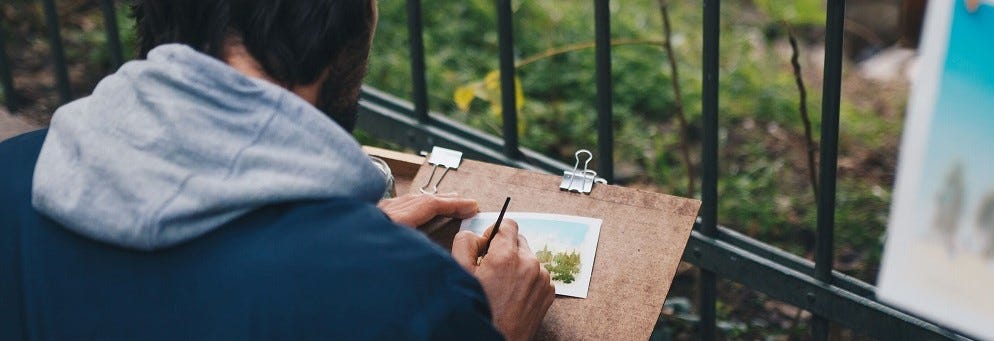It was the Impressionist artists of the 1800’s that decided to break out of their confined studios and burst into nature, chasing the sunlight. They scouted out their locations with an easel in tow and began to paint their canvases “en plein air” meaning they painted “in the open air.” This style of painting is a great way to get outside and reconnect with nature, so make like Monet and follow along for our 10 plein air painting tips.
1. Travel light

Instead of carrying an entire range of paints, stick to a few key colours in tubes rather than pots or bottles. Think primary colours and a few extras like burnt umber, vermillion, a medium yellow, a sap green, deep cyan and titanium white. If watercolour is your choice of medium, reach for a box of watercolour pan paints over tubes and a sketch pad or block with taped edges will be easier to carry than a board and paper. If you’re plein air painting with oils you can carry your turps in a screw container and be sure to carry an old tea towel to clean your brushes rather than paper towel or kitchen roll.
2. Consider your easel

A box easel is perfect for plein air painting, they combine an easel with a paint box so you can get the best of both worlds, and they can be folded up for easier carrying. Not only can a box easel be used for handy storage, they also have more stability than a regular easel – a feature which, if the wind picks up, you’ll be thankful for.
Tripod easels are another great option because they’re easy to assemble, carry and fold away. Pochade boxes combine a box with a palette making them great for working on the go. The box will hold your supplies and the lid can work like a slide-out palette.
3. Organise your palette

Our next plein air painting tip is to organise your palette. Lay the colours out onto your palette first so you can easily reach for the colours you want in a flash while the sunrise or sunset is still visible. This way you can mix or reach over for the colours you’re after, rather than squeezing out each individual colour as you go.
4. Dress to impress

When painting outdoors, be sure to wear loose clothing, a hat, mild sunglasses, sunscreen and insect repellent to protect yourself from sunburn and any glare you might face when painting in the open air.
5. Try colour studies

When it comes to en plein air painting, time is of the essence, so try a colour study. Paint the colours and shapes where you see them without worrying too much about the detail. This will give you an idea of the composition and an idea of the dark to light values, so if you begin to lose the light while painting, you have a rough idea of where your colours need to be.
6. Be prepared

One of the most important plein air painting tips is to be prepared. Make sure you bring plenty of water for yourself and your paint if you’re painting acrylic or watercolour. If the weather becomes too much you can always take your painting back to the studio to finish and who knows, a new pair of eyes can make for a fresh perspective.
7. Try an impressionist style

When plein air painting, an impressionist style will help you paint quickly to capture the fleeting light. If realism is more your style you can paint the tones in quickly like a colour study and take it back to the studio to add in the finer details.
8. Scale your paintings

To capture that golden hour, you will want to paint quickly so reach for a canvas or board that’s not too large if you’re looking to capture the light. Try a canvas panel or board around 40.6 X 50.8 cm (16 X 20 inches) and pre-tint the canvas before heading outdoors so you’re not wasting precious painting time.
9. Create a viewfinder for a new perspective

If you feel overwhelmed with a large landscape, try creating your own view finder and look through the scene like a camera. Take a piece of black cardboard around 12.5 cm X 10cm (5 x 4 inches) and cut a window smack bang in the middle, 7cm X 5cm (3 x 2 inches).
This view finder can help you focus on key areas or even show you an area you might have otherwise overlooked.
10. Keep your work out of the sun

It might seem like a good idea to paint directly in the light but it can cause the opposite and be harder to see the tonal values when painting because the colours will look lighter in direct sunlight. Stand in the shade and or use an umbrella where you can. This will keep your colours correct and can also help stop stray leaves and bugs falling onto your canvas.
Looking for more? Check out our how to use a painting board article before heading out to the field.





























